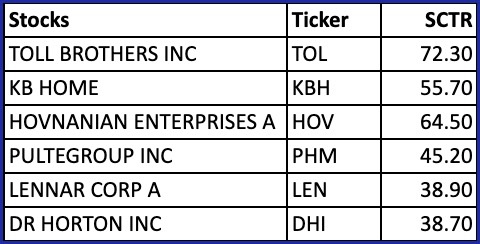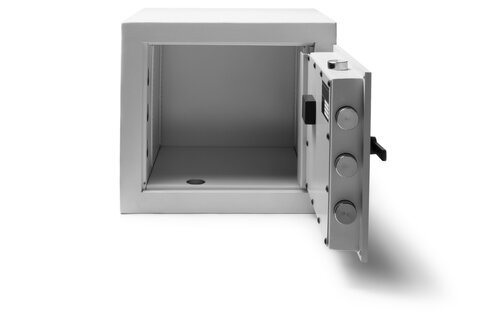 Homebuyers are still on the sidelines, waiting for better mortgage rates, while homebuilders are gearing up for a potentially strong 2025. Despite mortgage rates hitting two-year lows, buyers are holding back, expecting rates and prices to drop further.
Homebuyers are still on the sidelines, waiting for better mortgage rates, while homebuilders are gearing up for a potentially strong 2025. Despite mortgage rates hitting two-year lows, buyers are holding back, expecting rates and prices to drop further.
Here’s the big question: Are we seeing the bottom of a downward cycle about to turn up? In other words, are we seeing the early stages of an uptrend in homebuilders? And if so, which homebuilding stock might you want to add to your ChartLists?
Let’s start by analyzing the homebuilders using SPDR S&P Homebuilders ETF (XHB) as a proxy. Take a look at the weekly chart.
FIGURE 1. WEEKLY CHART OF XHB. Note how XHB has been reacting to the 50-week exponential moving average envelope.Chart source: StockCharts.com. For educational purposes.
Since XHB crossed above the 50-week exponential moving average envelope (EMA envelope) in early 2023, note the ETF’s bullish reaction, bouncing within range of the channel’s uptrend. You can also use the EMA envelope channel to gauge the strength of the uptrend (the further away it is toward the upside, the stronger the trend).
The big question: Can XHB keep riding its current uptrend? The ETF has bounced off the 50-week EMA envelope three times in the past two years, hinting at a possible trend continuation.
But not all of XHB’s holdings are pure homebuilders—companies like Home Depot and Lowe’s are in the mix too. That means you’ll need to pick your stocks wisely. So, let’s pick the most liquid and recognizable homebuilder stocks and check their technical strength by looking at their StockChartsTechnicalRank (SCTR) scores.
Homebuilding Stocks Ranked by SCTR
The following table lists the six most well-known stocks in the XHB fund and their corresponding SCTR score.

What might this look like on a year-to-date basis in terms of market performance? To get a perspective on this, take a look at each stock using PerfCharts:
FIGURE 2. PERFCHARTS YEAR-TO-DATE VIEW OF ALL STOX STOCKS’ MARKET PERFORMANCE. Note that TOL, KBH, and PHM outperformed XHB.Chart source: StockCharts.com. For educational purposes.
Year-to-date, TOL, XBH, and PHM were the top performers, but, since TOL’s SCTR score was significantly higher, perhaps it’s best to zero in on TOL, letting the other ones go for the moment. Still, add all six to your ChartLists in anticipation of a broad homebuilder recovery. Once the industry turns upward, their SCTRs will likely show changes that might make some of them more suitable for a “long” opportunity.
We’ll begin with a long-term view of TOL’s weekly chart.
TOL: Three Year Look-Back
Similar to XHB, but perhaps even more so, TOL is exhibiting a clear uptrend that is gaining strong traction. Note the pin bar this last week, signaling strong rejection from the weekly session lows.
FIGURE 3. WEEKLY CHART OF TOL. There’s a clear uptrend in the weekly price action and the stock is outperforming XHB.Chart source: StockCharts.com. For educational purposes.
Above the chart, you can see TOL’s relative performance against XHB. Looking at how far the line has risen above the zero level, you can see that TOL is outperforming its homebuilding peers by over 68%. Let’s shift to a daily chart.
TOL’s Daily Price Action
FIGURE 4. DAILY CHART OF TOL. The Raff Regression Line best captures TOL’s cyclical movement within an uptrend.Chart source: StockCharts.com. For educational purposes.
For TOL, you might consider plotting a Raff Regression Line for the following reasons:
- It identifies the trend direction.
- It captures TOL’s wide cyclical movement while projecting a wide range of potential support and resistance.
- It plots a clear channel to identify breaks and reversals.
With the regression line providing a clear picture of TOL’s trend, it’s best to use the On Balance Volume (OBV) to see the extent to which momentum supports (or diverges from) the price movement. In the example above, buying pressure aligns with TOL’s continued uptrend (see magenta line).
If you plan to go long, the best buying opportunity within the Raff Regression Channel typically occurs near the lower boundary (which attests to its recent bounce), as this area often serves as dynamic support and reflects potential price bounces. For risk management, placing a stop loss just below the lower boundary or beneath the most recent swing low is probably your best bet. This ensures protection in case the price closes below the channel, which could indicate a break in support and a potential trend reversal.
At the Close
Homebuilders are gearing up for a rebound despite homebuyers standing on the sidelines. If the industry begins showing green shoots of capital inflows (keep an eye on XHB to monitor this), it might present an opportunity to get in early on a potentially strong uptrend. But, until then, keep several homebuilding stocks on your ChartLists and monitor them regularly. For now, TOL is showing considerable strength, but, once the industry’s tide rises, it’ll take the strongest stocks up with it, so be ready.

Disclaimer: This blog is for educational purposes only and should not be construed as financial advice. The ideas and strategies should never be used without first assessing your own personal and financial situation, or without consulting a financial professional.



























